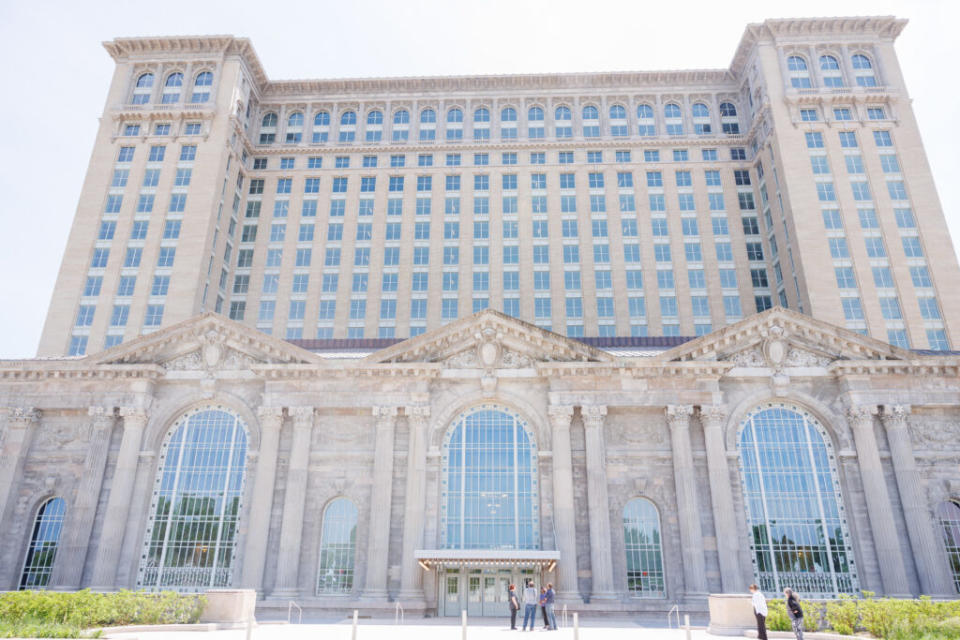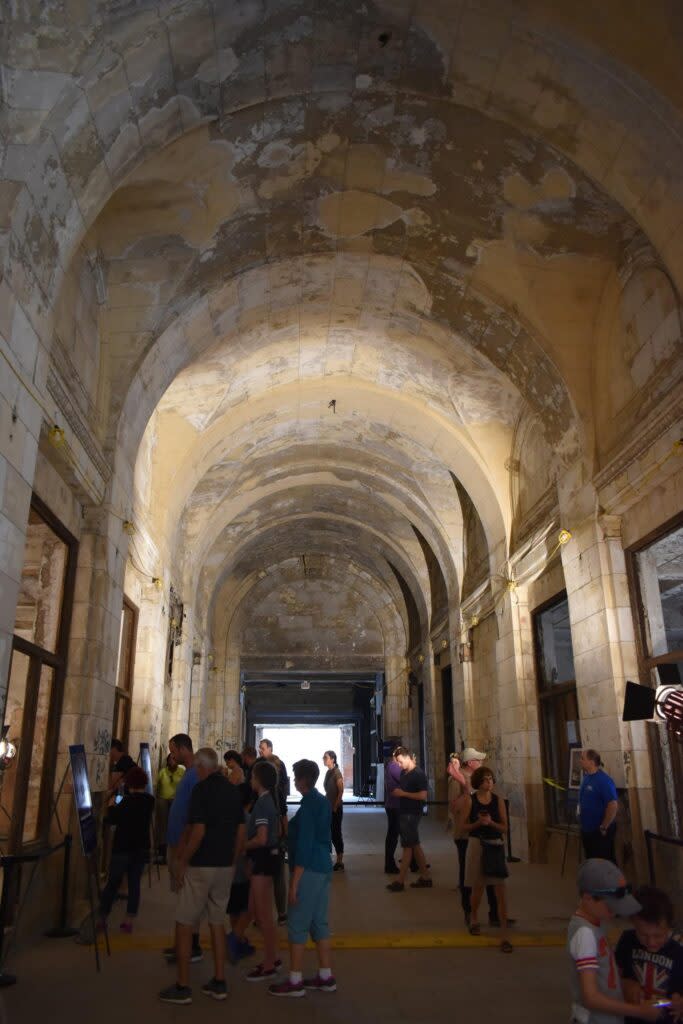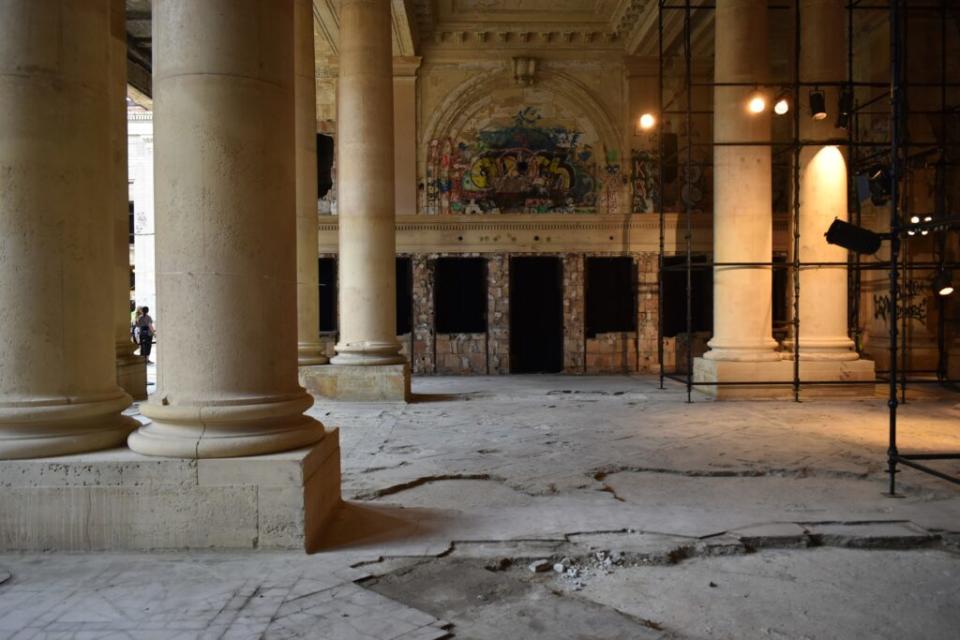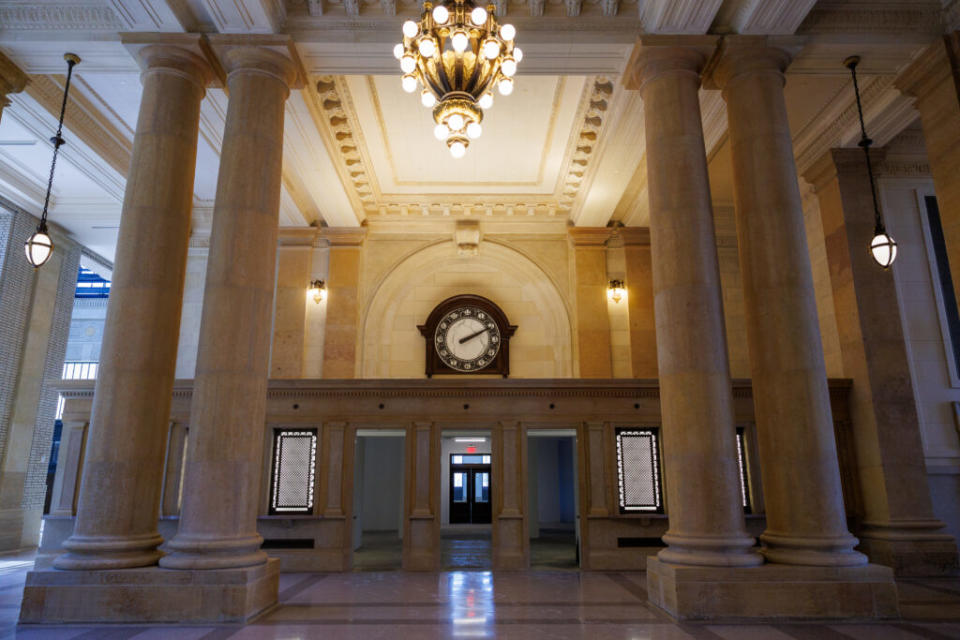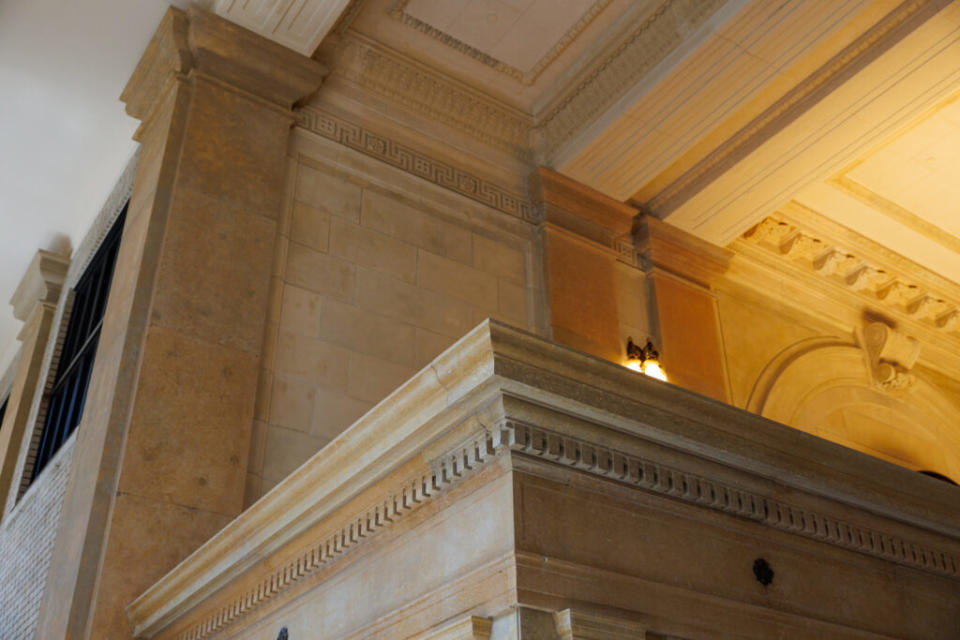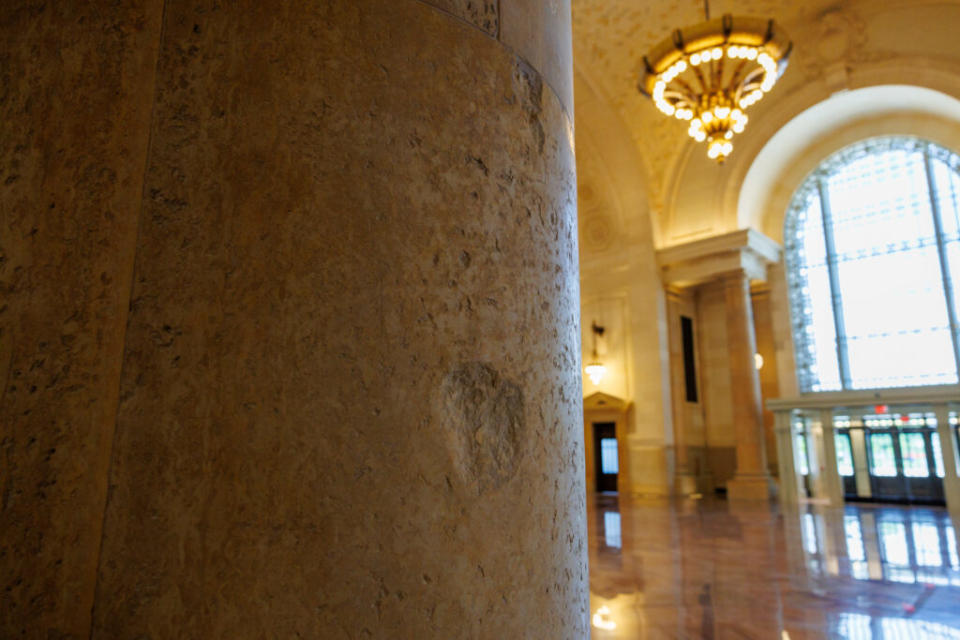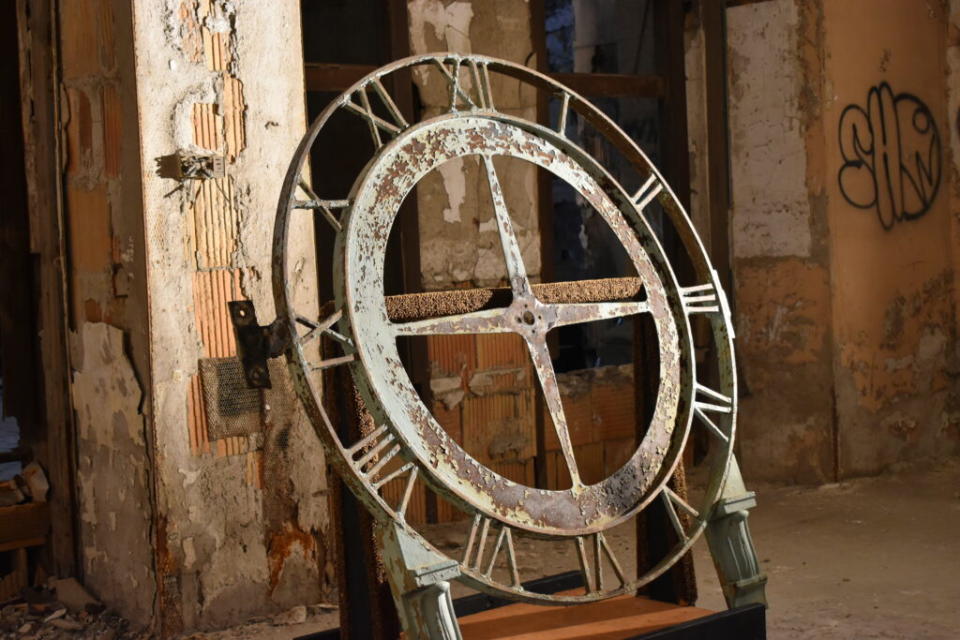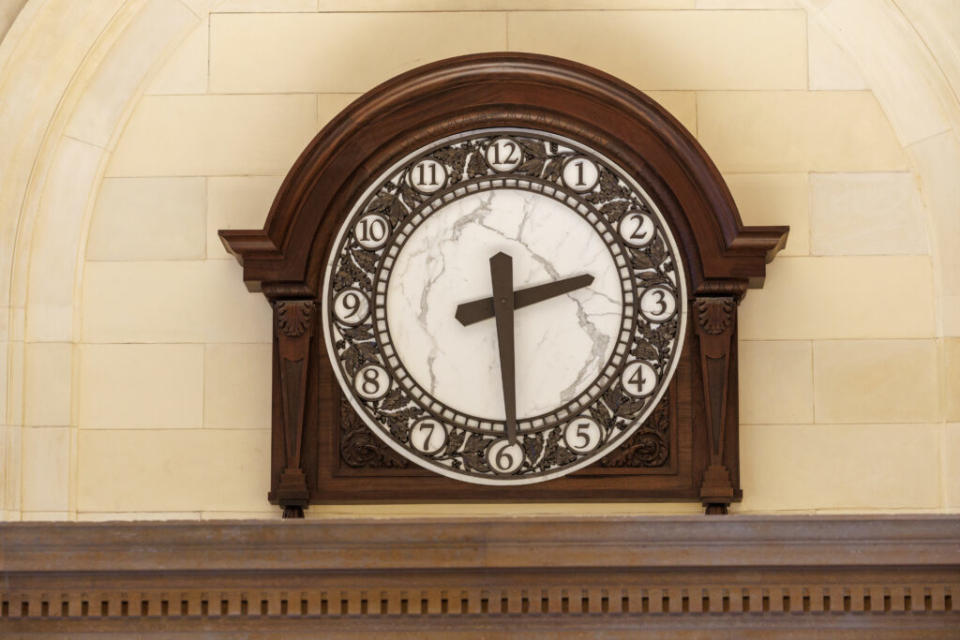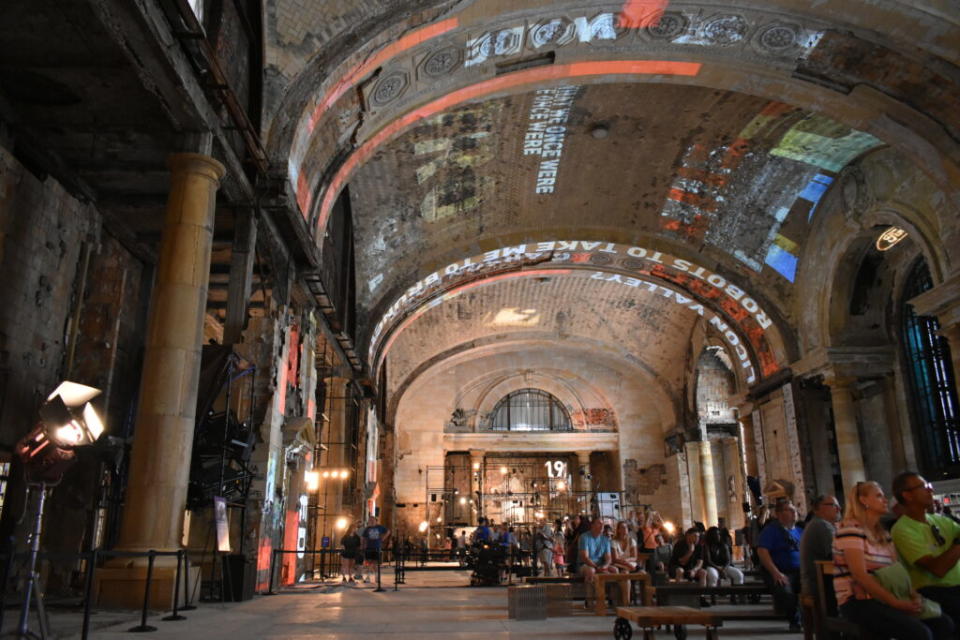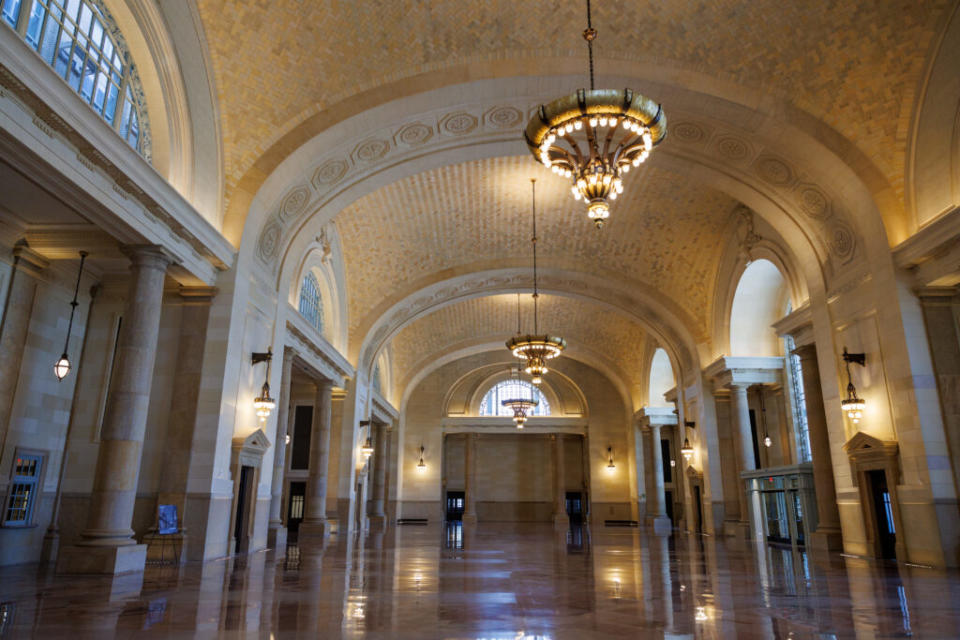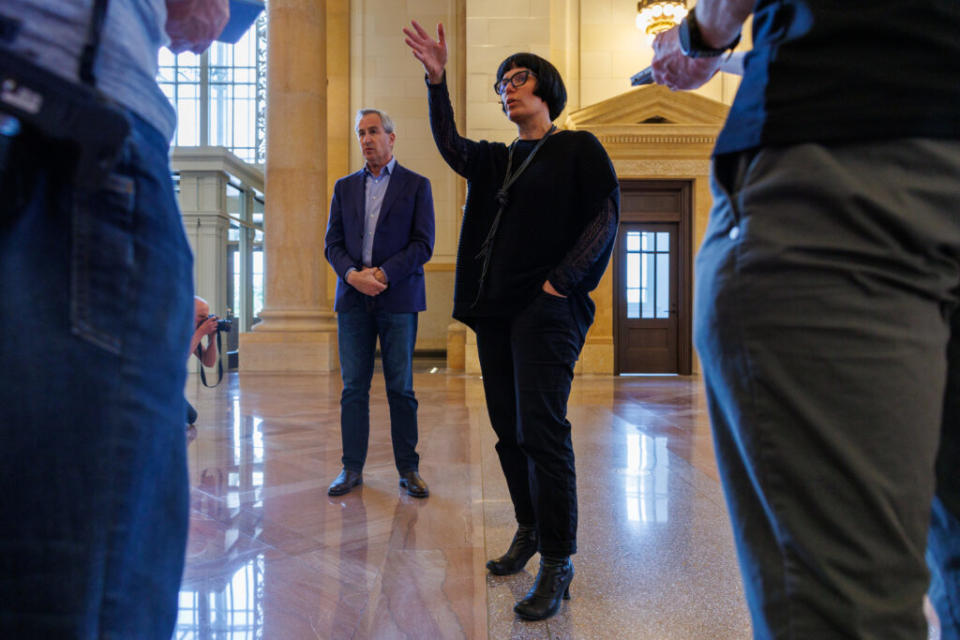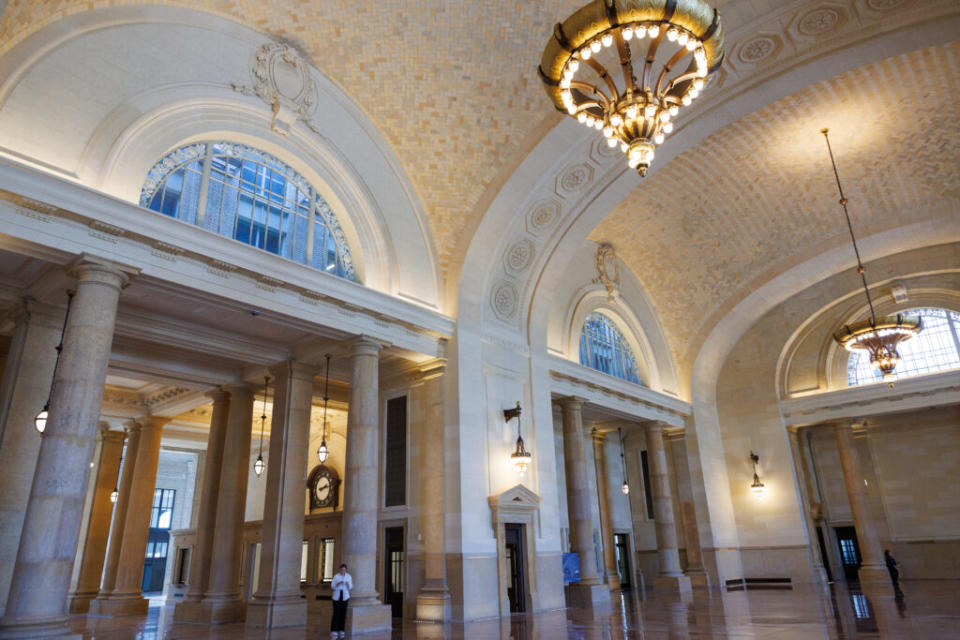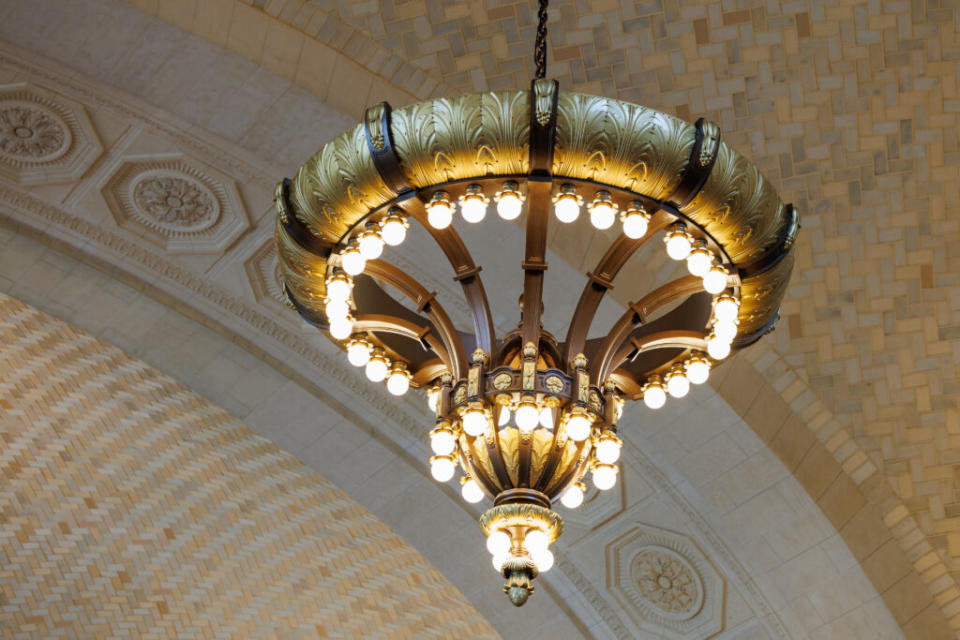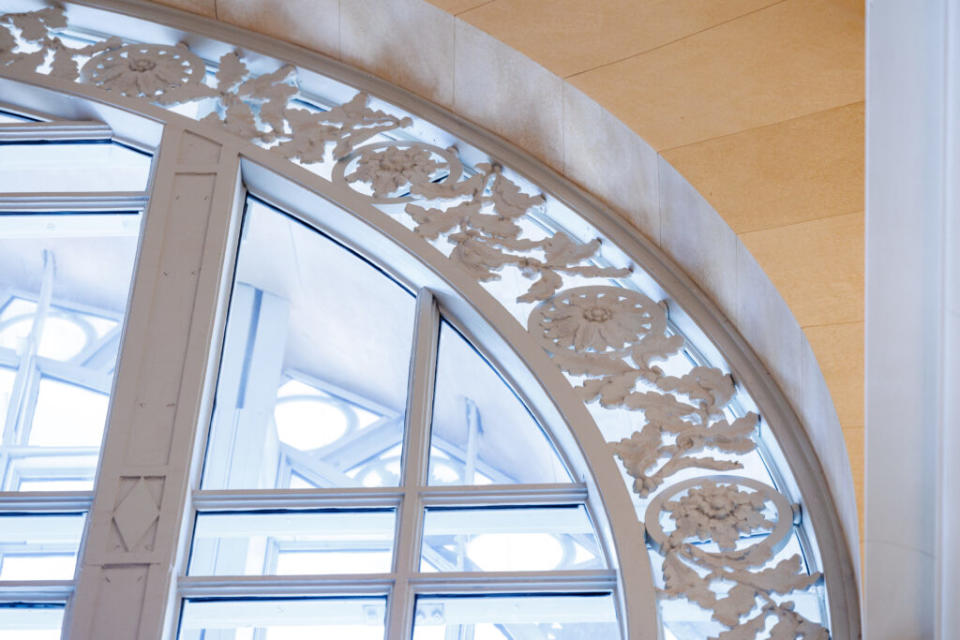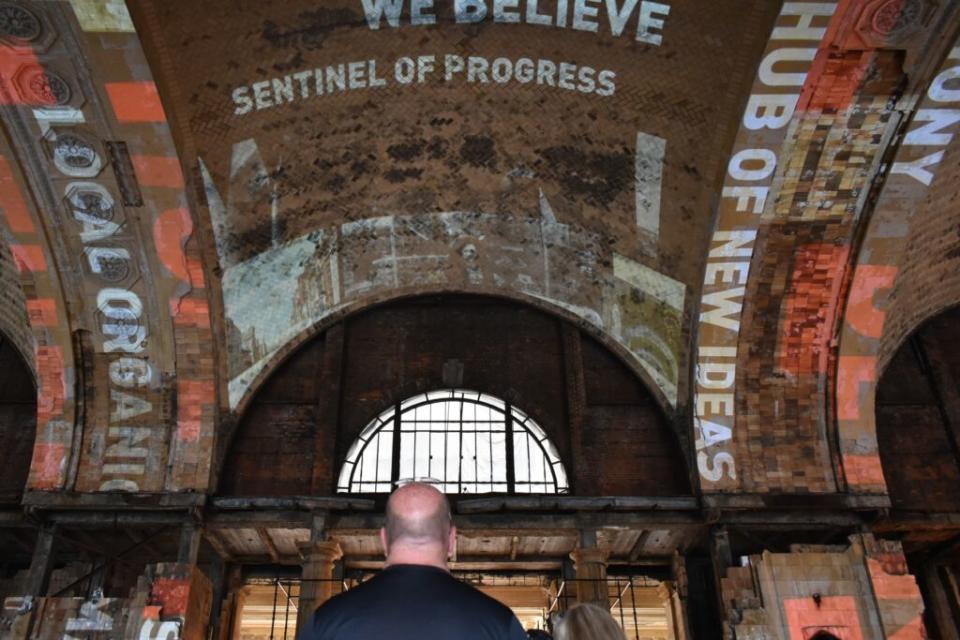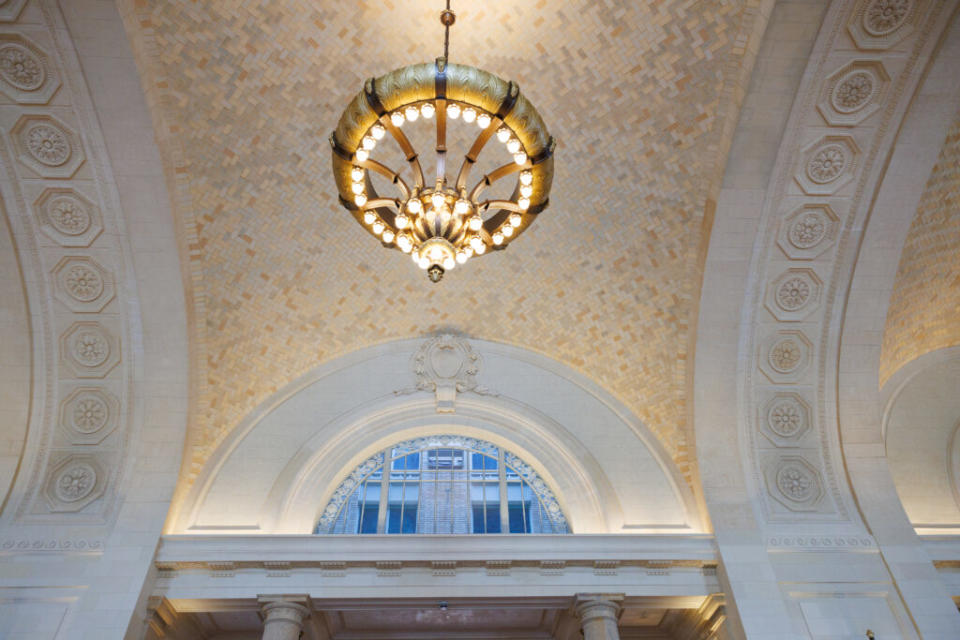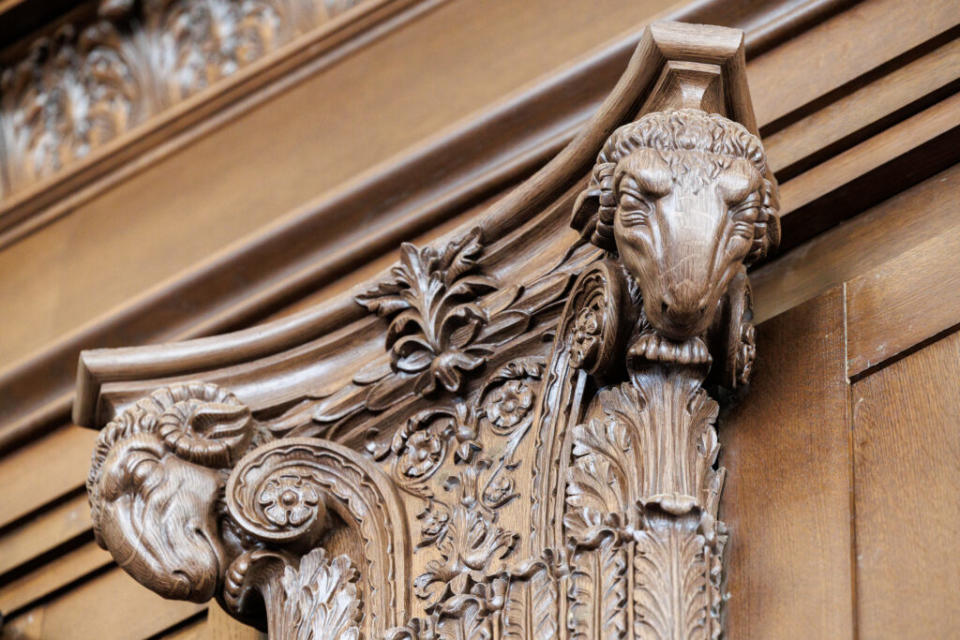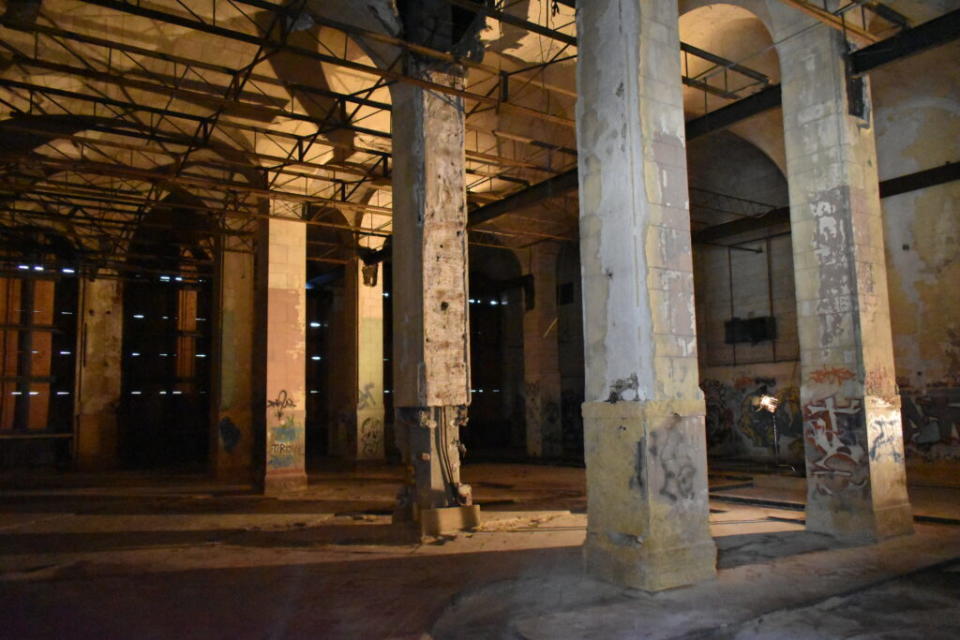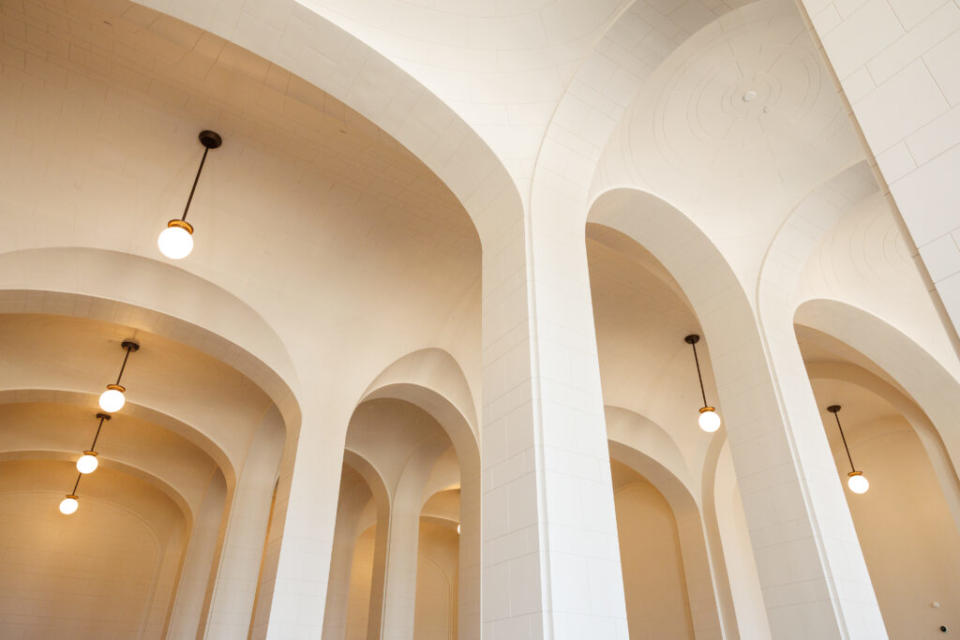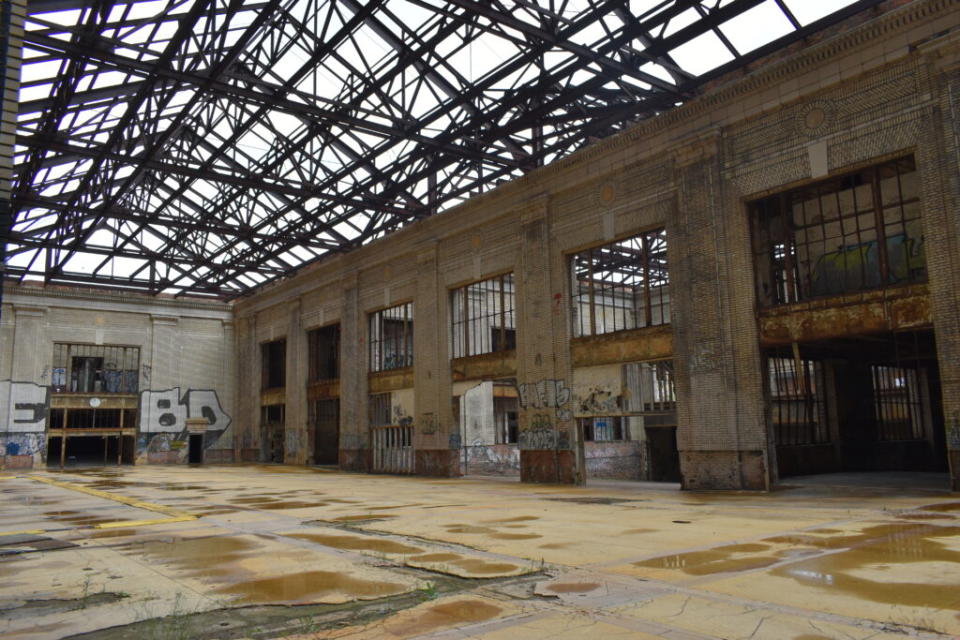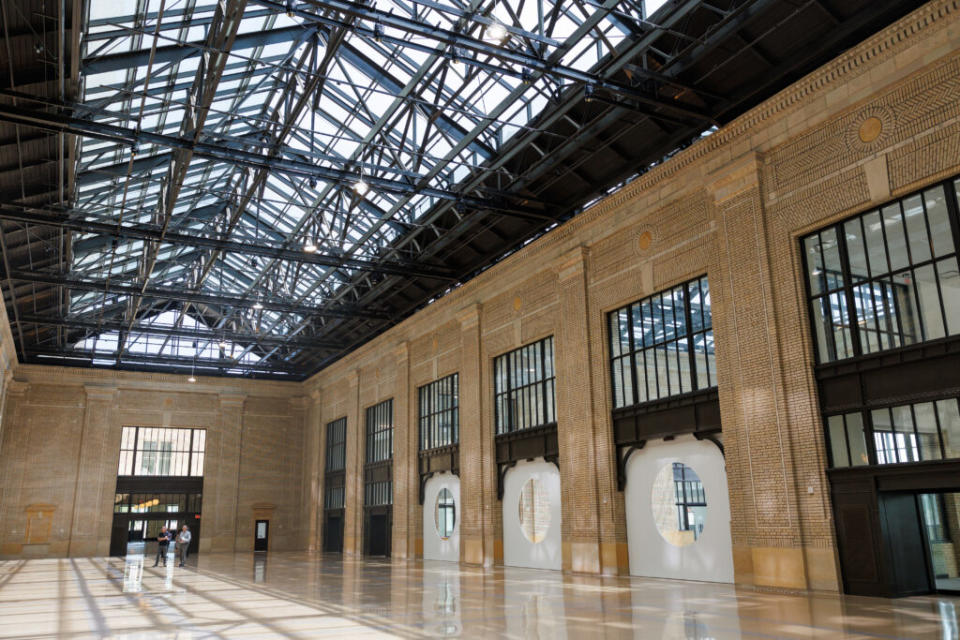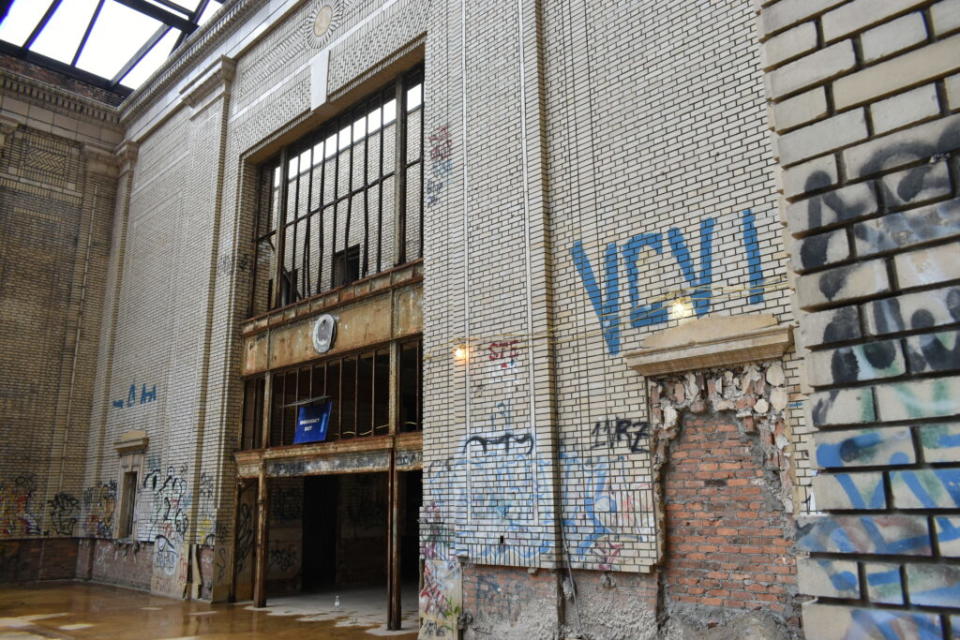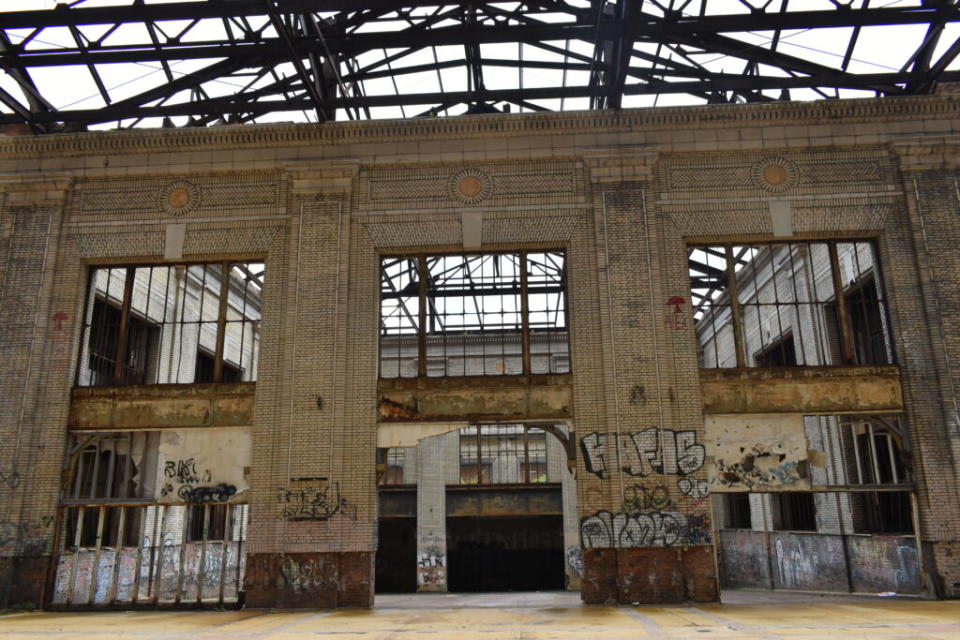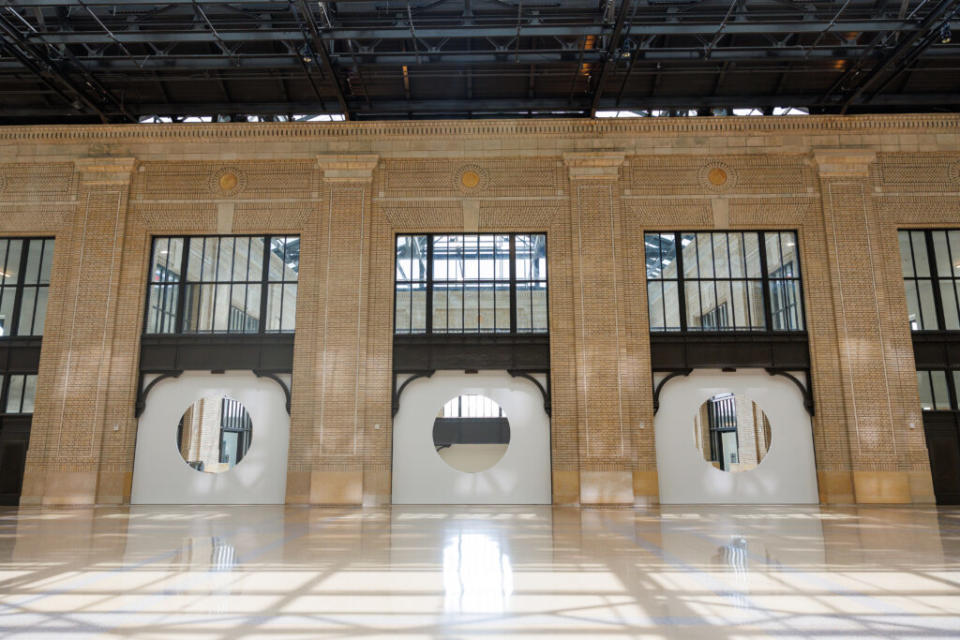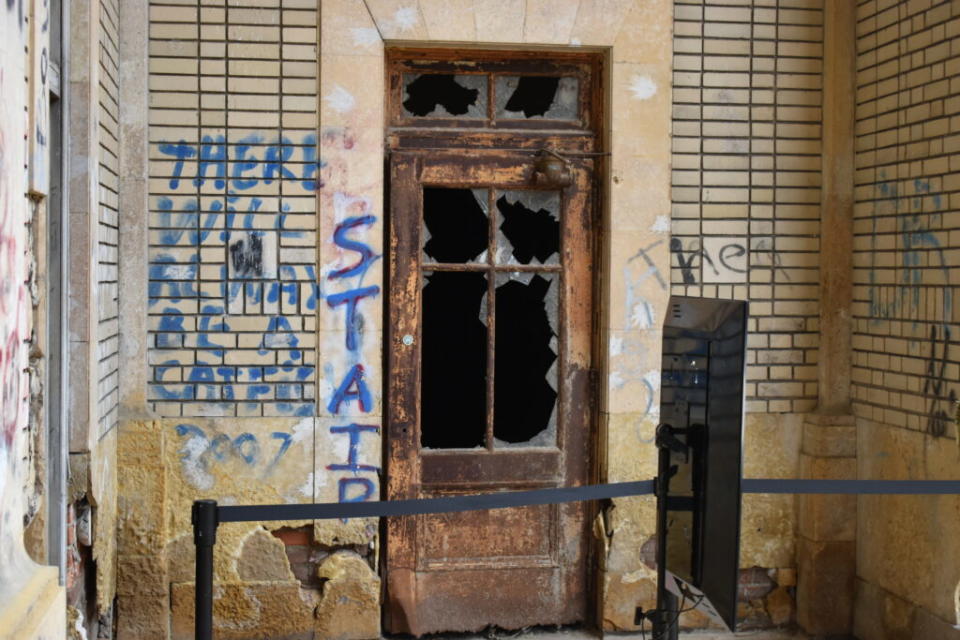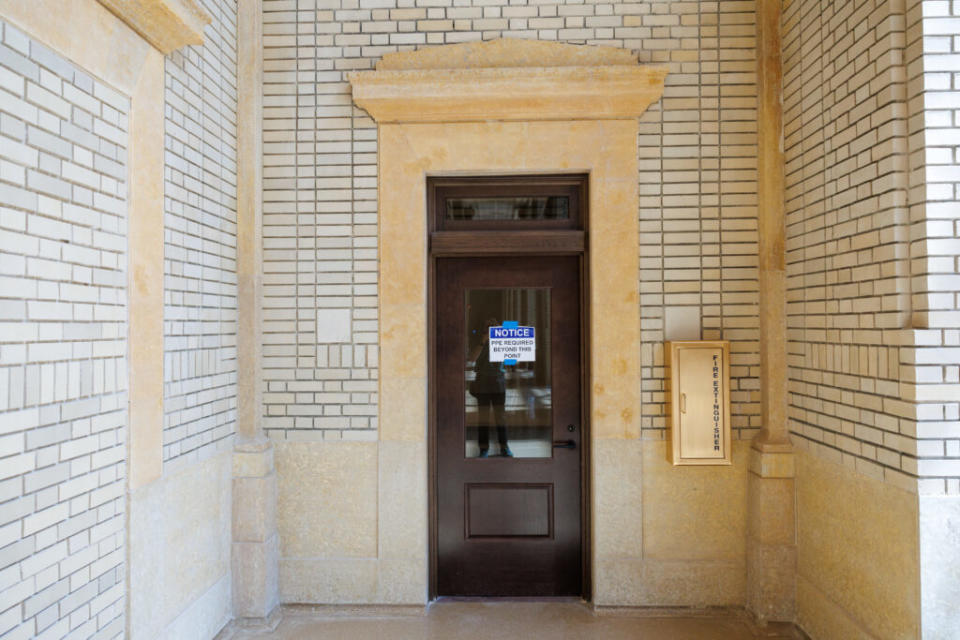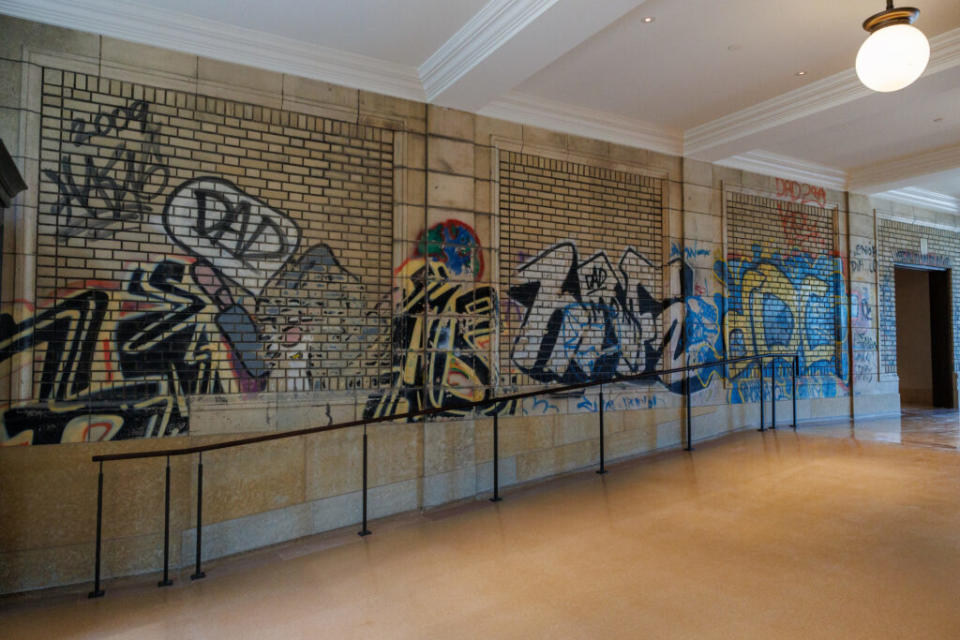Michigan Central Station reopens in its ‘most pristine state ever’
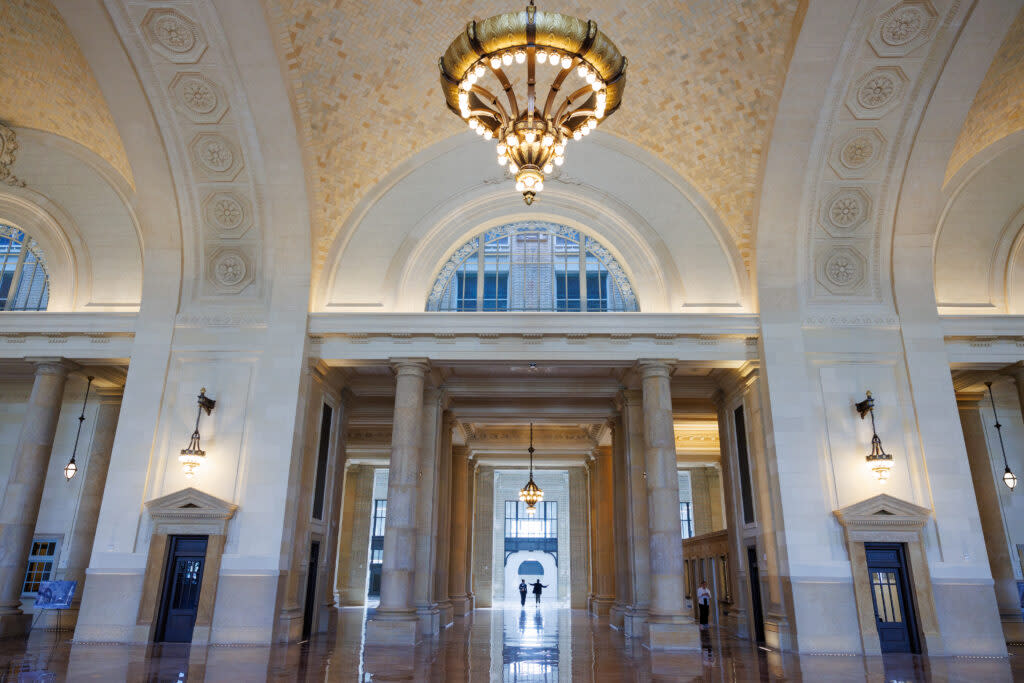
Ford previews the Grand Hall of Michigan Central Station on May 14, 2024, following a multi-million dollar renovation to save the decaying train station after it had been abandoned for decades. (Photo by Andrew Roth/Michigan Advance)
Imagine taking a ride in a carriage, or a trolley, or a car — depending on the decade — to the east end of an 18-story train station in Detroit.
Upon entering, maybe you continue on to the ticket windows, or the ornate Grand Hall. Or, perhaps, you take an elevator from the East Arcade up into the tower where you will clock in for a day of work.
At its peak in the 1940s, this was the routine for more than 4,000 people who passed through Michigan Central Station in Detroit every day.
The train station, designed by the same firms as New York’s Grand Central Terminal, served as a hub for Detroit for many years after its opening in 1913: It offered the first glimpse of the city to new immigrants, and the last sights to soldiers leaving for World War II.
But as the transportation industry evolved — thanks, in no small part, to Detroit – the station saw declining visitors, leading to its eventual closure in 1988.
Ambassador Bridge owner Manuel (Matty) Moroun bought the station out of tax foreclosure in 1995, leaving it to decay as a result of exposure to the elements and vandals in its prolonged vacancy. In the years that followed, Detroit suffered during a decade-long recession as its population continued to shrink and city government faced huge deficits. The crumbling building became a powerful symbol of the city’s struggles.
Gallery: Michigan Central Station, before and after
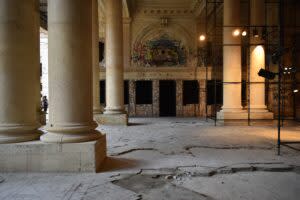
The ticket office of Michigan Central Station is open to the public for the first time in decades on June 23, 2018 after Ford purchased the former train station. (Photo by Andrew Roth/Michigan Advance)

Ford previews the ticket office of Michigan Central Station on May 14, 2024, following a multi-million dollar renovation to save the decaying train station after it had been abandoned for decades. (Photo by Andrew Roth/Michigan Advance)
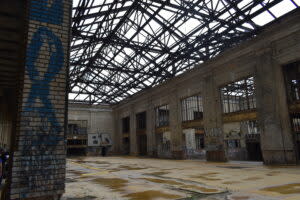
The South Concourse of Michigan Central Station is open to the public for the first time in decades on June 23, 2018 after Ford purchased the former train station. (Photo by Andrew Roth/Michigan Advance)
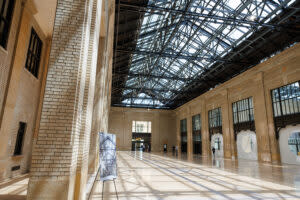
Ford previews the South Concourse of Michigan Central Station on May 14, 2024, following a multi-million dollar renovation to save the decaying train station after it had been abandoned for decades. (Photo by Andrew Roth/Michigan Advance)
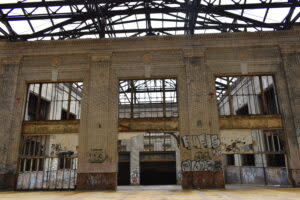
The South Concourse of Michigan Central Station is open to the public for the first time in decades on June 23, 2018 after Ford purchased the former train station. (Photo by Andrew Roth/Michigan Advance)
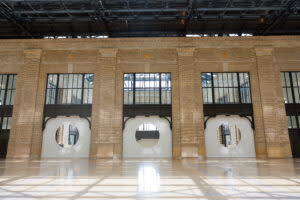
Ford previews the South Concourse of Michigan Central Station on May 14, 2024, following a multi-million dollar renovation to save the decaying train station after it had been abandoned for decades. (Photo by Andrew Roth/Michigan Advance)

The South Concourse of Michigan Central Station is open to the public for the first time in decades on June 23, 2018 after Ford purchased the former train station. (Photo by Andrew Roth/Michigan Advance)
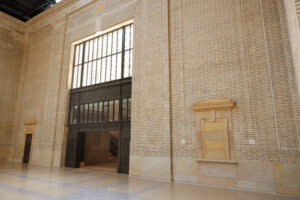
Ford previews the South Concourse of Michigan Central Station on May 14, 2024, following a multi-million dollar renovation to save the decaying train station after it had been abandoned for decades. (Photo by Andrew Roth/Michigan Advance)
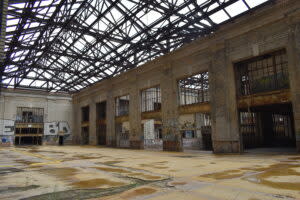
The South Concourse of Michigan Central Station is open to the public for the first time in decades on June 23, 2018 after Ford purchased the former train station. (Photo by Andrew Roth/Michigan Advance)

Ford previews the South Concourse of Michigan Central Station on May 14, 2024, following a multi-million dollar renovation to save the decaying train station after it had been abandoned for decades. (Photo by Andrew Roth/Michigan Advance)

The Grand Restaurant of Michigan Central Station is open to the public for the first time in decades on June 23, 2018 after Ford purchased the former train station. (Photo by Andrew Roth/Michigan Advance)

Ford previews the Grand Restaurant of Michigan Central Station on May 14, 2024, following a multi-million dollar renovation to save the decaying train station after it had been abandoned for decades. (Photo by Andrew Roth/Michigan Advance)
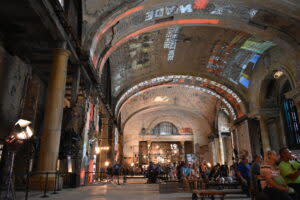
The Grand Hall of Michigan Central Station is open to the public for the first time in decades on June 23, 2018 after Ford purchased the former train station. (Photo by Andrew Roth/Michigan Advance)
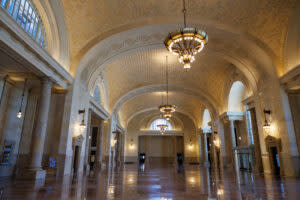
Ford previews the Grand Hall of Michigan Central Station on May 14, 2024, following a multi-million dollar renovation to save the decaying train station after it had been abandoned for decades. (Photo by Andrew Roth/Michigan Advance)

The Grand Hall of Michigan Central Station is open to the public for the first time in decades on June 23, 2018 after Ford purchased the former train station. (Photo by Andrew Roth/Michigan Advance)
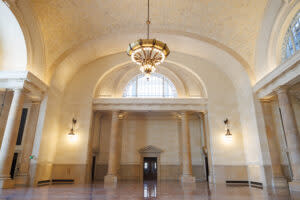
Ford previews the Grand Hall of Michigan Central Station on May 14, 2024, following a multi-million dollar renovation to save the decaying train station after it had been abandoned for decades. (Photo by Andrew Roth/Michigan Advance)

The South Concourse of Michigan Central Station is open to the public for the first time in decades on June 23, 2018 after Ford purchased the former train station. (Photo by Andrew Roth/Michigan Advance)

Ford previews the South Concourse of Michigan Central Station on May 14, 2024, following a multi-million dollar renovation to save the decaying train station after it had been abandoned for decades. (Photo by Andrew Roth/Michigan Advance)
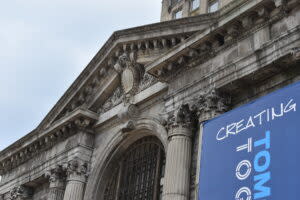
The exterior facade of Michigan Central Station during an open house on June 23, 2018 after Ford purchased the former train station. (Photo by Andrew Roth/Michigan Advance)

The exterior facade of Michigan Central Station on May 14, 2024. Ford negotiated to reopen the Dark Hollow quarry where limestone used on the historic structure was originally sourced to ensure sections that had to be reconstructed would fit in. There is some color variation from a natural aging and patina process. (Photo by Andrew Roth/Michigan Advance)
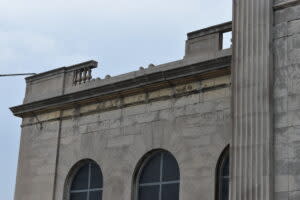
The exterior facade of Michigan Central Station during an open house on June 23, 2018 after Ford purchased the former train station. (Photo by Andrew Roth/Michigan Advance)
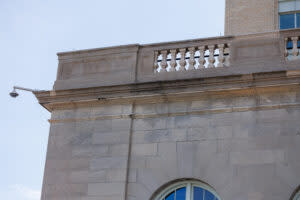
The exterior facade of Michigan Central Station on May 14, 2024. Ford negotiated to reopen the Dark Hollow quarry where limestone used on the historic structure was originally sourced to ensure sections that had to be reconstructed would fit in. There is some color variation from a natural aging and patina process. (Photo by Andrew Roth/Michigan Advance)
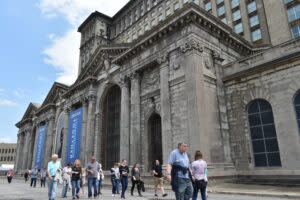
The exterior facade of Michigan Central Station during an open house on June 23, 2018 after Ford purchased the former train station. (Photo by Andrew Roth/Michigan Advance)

The exterior facade of Michigan Central Station on May 14, 2024. Ford negotiated to reopen the Dark Hollow quarry where limestone used on the historic structure was originally sourced to ensure sections that had to be reconstructed would fit in. There is some color variation from a natural aging and patina process. (Photo by Andrew Roth/Michigan Advance)

The South Concourse of Michigan Central Station is open to the public for the first time in decades on June 23, 2018 after Ford purchased the former train station. (Photo by Andrew Roth/Michigan Advance)
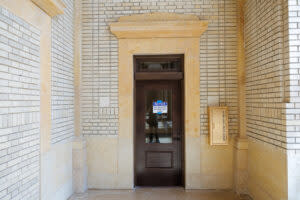
Ford previews the South Concourse of Michigan Central Station on May 14, 2024, following a multi-million dollar renovation to save the decaying train station after it had been abandoned for decades. (Photo by Andrew Roth/Michigan Advance)
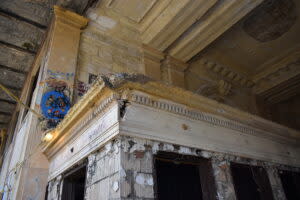
The ticket office of Michigan Central Station is open to the public for the first time in decades on June 23, 2018 after Ford purchased the former train station. (Photo by Andrew Roth/Michigan Advance)

Ford previews the ticket office of Michigan Central Station on May 14, 2024, following a multi-million dollar renovation to save the decaying train station after it had been abandoned for decades. (Photo by Andrew Roth/Michigan Advance)
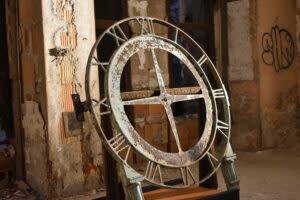
The wooden clock of Michigan Central Station is displayed to the public for the first time in decades on June 23, 2018 after Ford purchased the former train station. (Photo by Andrew Roth/Michigan Advance)
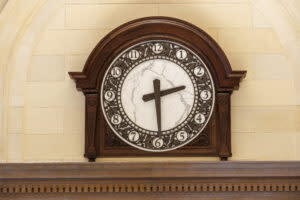
Ford previews the ticket office of Michigan Central Station on May 14, 2024, following a multi-million dollar renovation to save the decaying train station after it had been abandoned for decades. (Photo by Andrew Roth/Michigan Advance)
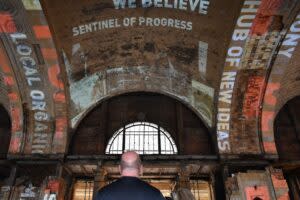
The Grand Hall of Michigan Central Station is open to the public for the first time in decades on June 23, 2018 after Ford purchased the former train station. (Photo by Andrew Roth/Michigan Advance)

Ford previews the Grand Hall of Michigan Central Station on May 14, 2024, following a multi-million dollar renovation to save the decaying train station after it had been abandoned for decades. (Photo by Andrew Roth/Michigan Advance)
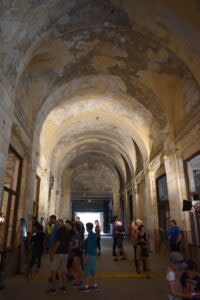
The East Arcade of Michigan Central Station is open to the public for the first time in decades on June 23, 2018 after Ford purchased the former train station. (Photo by Andrew Roth/Michigan Advance)
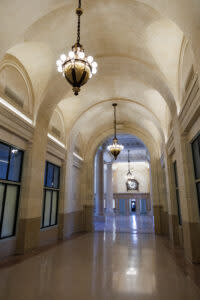
Ford previews the East Arcade of Michigan Central Station on May 14, 2024, following a multi-million dollar renovation to save the decaying train station after it had been abandoned for decades. While the walls are made to look like stone, they are actually plaster. The rose marble around the perimeter of the floor is original. (Photo by Andrew Roth/Michigan Advance)
After Detroit emerged from the largest municipal bankruptcy in history, Ford purchased the station in 2018 with plans for it to serve as the anchor of their Corktown campus, which is the hub for their autonomous vehicle development and deployment. Renovations were expected to be completed by 2022, but that was delayed by the COVID-19 pandemic and the uniquely complex challenges that experts faced in restoring the building to its former glory.
Once a symbol of Detroit’s decay, the building is set to reopen this week as what Gov. Gretchen Whitmer called “a living symbol of resurgence.”
Ford declined to reveal the cost of the renovations, instead offering a bundled number of $950 million that encompasses the entire Michigan Central campus, including the Albert Kahn-designed Book Depository next door, a three-story building first opened in 1936 as a U.S. Post Office that sat unused for about three decades but reopened last year with workspaces and studios for mobility-focused companies and technologies.
After decades as a popular urban exploring destination, Michigan Central chief executive officer Joshua Sirefman said that the train station is now “in its most pristine state ever,” noting that when it originally opened in 1913, it did so early as a result of a fire downtown.
“Right now it’s in that sort of beautiful state and we wanted to make sure that we took a moment for everybody to celebrate this building and all it represents,” Sirefman said.
While work on the upper floors is still underway, Ford plans to hold a grand opening celebration Thursday headlined by Diana Ross, Jack White, Big Sean and the Detroit Symphony Orchestra. Tickets to the free concert, which will be streamed on Peacock and is being executive-produced by Eminem and Paul Rosenberg, sold out within five minutes of becoming available to the general public after Corktown residents got first dibs.
The next day, thousands will once again fill the halls of Michigan Central as Ford kicks off 10 days of open house tours, which will continue on Fridays and Saturdays throughout the summer.
“We wanted to have a moment of celebration,” Sirefman said. “We think we have an obligation and responsibility and a desire for the community to see the building and participate in it.”
Sirefman and Melissa Ditmer, head of place for Michigan Central, walked media through the ground floor of the former train station on May 14, showing off the results of 1.7 million hours of work by 3,100 construction employees.
Before:
After:
Exterior
From the moment you arrive outside Michigan Central Station, you are immediately greeted by the ornate ornamentation on the towering 18-story structure.
The station is composed of two portions: The lower plinth that makes up the grand spaces, and accounts for a three-story façade, and the tower, which consists of 15 floors.
There is some color variation in the exterior limestone.
That’s because much of the limestone is from the original building.
“The different colors are a result of the aging and patina process that comes with stone,” Ditmer said. “Especially on the north side of the building, you’ll see there’s some slight color variations, and we find that very beautiful and didn’t want to remove that in its entirety because that’s part of the history.”
But Ford didn’t want too much variation. For sections that had to be reconstructed after decaying too much to be restored, it was important that the limestone be a close match to the original structure.
“When we went and searched quarries around us in the Midwest for limestone to match, we found that not all limestone is created equal,” Ditmer said.
Ford’s researchers were able to find the original quarry in Indiana, Dark Hollow, and negotiated with the owners to reopen the shuttered quarry and begin harvesting the limestone.
It would take a mason more than 400 hours to hand carve just one capital column out of a 22,000 pound block of limestone, which was then reinserted in the façade, Ditmer said.
Indiana limestone has also been used in the construction of structures like the Empire State Building, the National Cathedral and the Pentagon.
Benches outside the station are made using old rail tracks.
Before:
After:
East Arcade
For decades, the East Arcade, leading to elevator lobbies and ticket windows, served as one of the main entry points for people working in or traveling from Michigan Central Station.Over time, it will again become a key entry point for people visiting Michigan Central Station, as Ford plans to activate retail installations in this area of the station.
Most of this section was able to be restored with the original materials in place, including rose marble along the perimeter of the floor.
There is a historically accurate illusion at work in this area: The walls that appear to be stone are actually made of plaster, a cost-saving measure that was also employed in the construction of the Michigan Capitol.
“That was something that happened a lot in these grand spaces,” Ditmer said.
Before:
After:
Ticket windows
When restoration work began on the former train station, one of the first orders of business was to remove water that had been flooding the basement.
Because sections of the building had been missing a roof for years, water was able to seep in and eat away at portions of the building all over each floor.
More than 3.5 million gallons of water was pumped out of the station, taking about 18 months to complete, Ditmer said. The process was prolonged by the discovery of a sub-basement with additional flooding and progress being set back by floods in June 2021 that got a disaster declaration from President Joe Biden.
Damage from the flooding was so extensive that restoration would have been impossible had work started just two or three years later.
Before:
After:
That history is intact in the ticket window area, where Ditmer encouraged visitors to feel the Mankato columns, which have a three-dimensional pop markedness from years of water deterioration.
Rather than replacing the columns, they decided to keep “existing stone, sort of refurbished a bit, but not filled in, to account for that period of history,” Ditmer said.
As you get further up the column, there’s entirely new Mankato in place.
“This is just one example of an object that shows all the different chapters of the station’s history,” Ditmer said.
Another of those objects: The clock stationed prominently above the ticket windows.
After Ford’s purchase of Michigan Central Station was announced in 2018, many people came forward wanting to return artifacts taken from the building over the years. One of the artifacts returned was the historic wooden clock.
Every day, as 4,000 people came into Michigan Central Station, they would use the clock as a “visual beacon, helping them keep their time, their pace, where they need to go, what they need to do,” Ditmer said.
Restoration teams were able to salvage “a few remnants” of the clock, reconstructing the rest of it using historic drawings and detailed research,” Ditmer said.
Before:
After:
Grand Hall
[B/A: GrandWide]
To the right of the ticket windows is the ornate Grand Hall, where people would sit on heated wooden benches while waiting for their trains.
“I’m actually standing in one of them,” Ditmer said, pointing out the rectangle seen in the floor.
Before:
After:
The majority of that rose marble flooring is original, though Ditmer said there were a few areas where they had to harvest new marble to match the original.
Because most of the flooring survived the elements, you can find remnants of the past in it.
“There’s various locations around what were these oak benches where people sat. They’d look at the clock and wait for their train and swing their feet, and so the marble has been worn away,” Ditmer said. “As you walk through the space, look for those; those were the favored spots for people to sit, and it tells a really nice story.”
If you turn your attention from the floor to the ceiling, you will be greeted with 29,000 Guastavino tiles, many of which were able to be saved. New Guastavino tiles were recreated and inset to replace those that couldn’t be salvaged. All of the tiles were then regrouted to create unity.
“It is probably what will become one of the most grand spaces in this style in the world,” Ditmer said.
Hanging from the ceiling, you will find light fixtures that were meticulously recreated after working with archivists, historic lighting designers and lighting specialists. There were no lighting fixtures left when the station was purchased, which provided an opportunity to modernize the historic fixtures with LED lighting and integrate them within Ford’s lighting program and building management system.
[0392]
In addition to the light fixtures, natural light fills the Great Hall from the massive arched windows.
Small cast iron elements that were then welded together create a filigree of rosettes around the windows.
“Most of that was gone and had either fallen off over time or walked away from the building in some capacity,” Ditmer said. “We managed to salvage and find quite a few of them, and then Ford Manufacturing 3D printed the rest.”
Thirteen-foot cartouches sitting at the apex of the window were restored using “varying levels of design, restoration and construction,” including 3D scanning, Ditmer said.
“That became another example of what it takes to restore a vacant building such as this,” Ditmer said. “How do we remove those materials, how do we scan those in or create plaster castings of those materials to then either put them back up in place with a stabilized structure or create a new casting that allows sort of historic replication methods to be applied?”
Beyond providing natural light, the windows also played a key role in cooling the building in the past. While the building is now air conditioned, meaning the windows will likely not open going forward, the internal mechanics have been salvaged, Ditmer said.
[B/A: Arches]
Going forward, the space is expected to be used for events, productions, performances and exhibits, Sirefman said.
“Our aspiration is that as often as possible, the space should be activated with reason for people to have a connection to the building,” Sirefman said. “So many people have direct emotional connections to the building, either themselves or their family history or whatever it may be, and the events that happen here should provide the next generation of that.”
Detroit Mayor Mike Duggan delivered his State of the City address in the space last year.
Before:
After:
Reading rooms
On either side of the Grand Hall are two smaller reading rooms.
“While the Grand Hall was a democratic waiting room, on either side there was a men’s reading room and a women’s reading room,” Sirefman said.
Because the rooms are heavily made of wood, they did not fare well against the elements over the years.
Ram head column capitals were, like the filigree around the Grand Hall’s windows, 3D printed after researchers were able to find artifacts to scan.
Like the ram heads, the inlaid ceiling was also mostly missing. Ditmer called it “yet another example of very carefully removing the existing materials, documenting them and then working to get what you see today.”
Nearly all of the wooden floors had also been removed, but architects knew it was herringbone because the pattern of the herringbone had been etched into the concrete slab below, Ditmer said.
The wooden rooms have a very warm atmosphere compared to the largely stone grandeur seen in the rest of the station.
“This is a great space to walk into, because the smells add just as much to the refined material palette,” Ditmer said. “It is clearly all brand new oak, all emitting a refined state of what this building once was.”
These rooms will also be used for events, Sirefman said.
Before:
After:
Grand Restaurant
Perhaps the most echoey room in the station, Sirefman said the architectural beauty of this space was covered up at some point.
“Through the years, probably for energy efficiency, a drop ceiling was added,” Sirefman said. “So the arches, which are all entirely reconstructed to the original plans, were gone, but the vast volume was discovered after taking down that drop ceiling.”
A service hallway next to the Grand Restaurant showcases the dumbwaiters where food from the downstairs kitchen would be lifted into the restaurant space.
A staircase employees would use to take their lunch upstairs remains untouched.
“It’s an example of where, in some cases, we’ve left artifacts in place, and we’ll figure out how to programmatically weave them into the experience in the building,” Sirefman said. “We’ve tried to, wherever possible, really reference that history and include it in the storytelling.”
Over time, Sirefman said the hope is for the Grand Restaurant to once again become a destination for dining.
Looking out the window of the Grand Restaurant, you can get a glimpse of the Carriage House, where work is still underway.
Ford is currently working through an amendment to their zoning that would allow hospitality in the building, and Sirefman said the Carriage House is “likely to play a meaningful role” should Michigan Central Station successfully land a hotel.
“It will be a really spectacular toolbox, especially within relation to the bigger station building overall,” Sirefman said.
Before:
After:
South Concourse
Once the bustling hub of catching your train, getting your tickets and dropping off luggage, the South Concourse is expected to once again become the epicenter for public activity.
“This should be a space where you can always gather,” Sirefman said. If you say meet me at Michigan Central, this is likely to be that place.”
The South Concourse will eventually host dining opportunities and an art venue. But Sirefman said that it should be accessible regardless of whether you are a customer.
“It can almost be like … a third space,” Sirefman said. “That space really is the gathering space, and that’s why we think about it as the public epicenter.”
Before:
After:
If you were arriving in Detroit by train, the area previously would have been your first sight of the city.
Ford is developing an eight acre park outside the south side of the building that Ditmer said will connect with the Southwest Greenway, “which will also then connect to the Joe Louis Greenway, and then the Ralph C. Wilson Park, and really will become, similar to the historic trains, through that open space network, a way in which all Detroit residents can come to Michigan Central Station and arrive on the south side similar to the way they were doing before.”
“People often associate the station as just facing Michigan Avenue. We want to really open up the connection to the southwest community,” Sirefman said. “I think you’ll find as we work through that design and build the space, that this will become just as much of an entrance as any other.”
Before:
After:
While temporary walls currently block off ramps to the train platforms, Sirefman said Ford has had early conversations with the public sector about potentially restoring passenger train service at some point.
“We’re optimistic about that, we’re hopeful,” Sirefman said. “We would love to see that happen, and we’ll certainly do our part.”
The park space on the south side of the station has been designed with that possibility in mind, Sirefman said.
“Nothing there would preclude the ability for passenger rail, and it could easily be adapted to it,” Sirefman said.
Conversations are early, but Speaker of the House Joe Tate (D-Detroit) said “it’s exciting to think about, having that existing infrastructure there.”
Even if passenger rail is reinstated, Sirefman said Michigan Central Station would not take on its former function as an active rail station.
The concourse serves as “a great story about the integration of contemporary advanced systems into older structures,” Sirefman said.
Before:
After:
Because the floors had to be completely rebuilt after sustaining years of weather damage, there was an opportunity to install in-floor cooling.
“We figured out extremely sneaky and innovative ways in which to modernize the whole building, so much so that we think it will become a national benchmark for the sort of innovation and future-forward building systems for historic structures,” Ditmer said.
And the cooling system isn’t the only place where they have blended old with new.
Graffiti remains on the walls along the entryway leading into the concourse.
“The period of 36 years where it was vacant is an important part of that story,” Sirefman said. “While it was vacant and not a train station, it also was home to a ton of creative and cultural activities, whether that’s graffiti, whether it is performances, raves, videos, you name it, it’s a really important part of the chapter of the building, and also one of the themes as we look to its next generation of use should be a critical part of that.”
Researchers at Ford went deep to understand the entirety of the graffiti throughout the building and extensively catalog what was there. Sirefman said there are some cases where pieces have been preserved, but not intact in the wall.
“Over time, we’ll figure out, perhaps, whether to incorporate them into exhibitory or design,” Sirefman said. “But we did think it was important to have moments throughout the building with these reminders of its different chapters.”
Michigan Central Station is receiving National Park Service historic tax credits, which come with certain requirements. In total, the project was awarded $300 million in state, local and historic rehabilitation tax incentives, CNBC reports.
“It was in those conversations where we set the tone that it was important to always keep materials, colors and things of this nature to represent all of the different chapters, and it just unfolded in different ways throughout the station,” Ditmer said.
While work is still ongoing on the upper levels, Ditmer said that “you’ll begin to see some of these other elements, this intersection of historic and vacant condition, and also the future-forward condition, all begin to show up, as we roll through to the next phases of interior architecture and beyond.”
The first occupancy in the tower is expected to begin later this month by Google, before Ford takes over three floors in the fall.
Sirefman said that the view from the top provides a reminder of the beacon of hope that Michigan Central Station can be for the rest of Detroit.
“When you’re looking down, you really appreciate how much Michigan Central is sort of the seam in the middle of so many things,” Sirefman said. “We’re designing and thinking about what kind of place it could be, with the goal of really playing that role of connecting all around in a very local way, and then at a sort of citywide and regional scale.”
Gallery: 2024 tour of Michigan Central Station

The exterior facade of Michigan Central Station on May 14, 2024. Ford negotiated to reopen the Dark Hollow quarry where limestone used on the historic structure was originally sourced to ensure sections that had to be reconstructed would fit in. There is some color variation from a natural aging and patina process. (Photo by Andrew Roth/Michigan Advance)
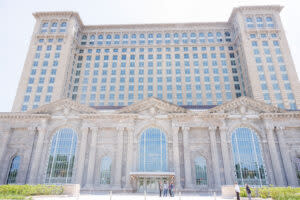
The exterior facade of Michigan Central Station on May 14, 2024. Ford negotiated to reopen the Dark Hollow quarry where limestone used on the historic structure was originally sourced to ensure sections that had to be reconstructed would fit in. There is some color variation from a natural aging and patina process. (Photo by Andrew Roth/Michigan Advance)

The exterior facade of Michigan Central Station on May 14, 2024. Ford negotiated to reopen the Dark Hollow quarry where limestone used on the historic structure was originally sourced to ensure sections that had to be reconstructed would fit in. There is some color variation from a natural aging and patina process. (Photo by Andrew Roth/Michigan Advance)

The exterior facade of Michigan Central Station on May 14, 2024. Ford negotiated to reopen the Dark Hollow quarry where limestone used on the historic structure was originally sourced to ensure sections that had to be reconstructed would fit in. There is some color variation from a natural aging and patina process. (Photo by Andrew Roth/Michigan Advance)

The exterior facade of Michigan Central Station on May 14, 2024. Ford negotiated to reopen the Dark Hollow quarry where limestone used on the historic structure was originally sourced to ensure sections that had to be reconstructed would fit in. There is some color variation from a natural aging and patina process. (Photo by Andrew Roth/Michigan Advance)

The exterior facade of Michigan Central Station on May 14, 2024. Ford negotiated to reopen the Dark Hollow quarry where limestone used on the historic structure was originally sourced to ensure sections that had to be reconstructed would fit in. There is some color variation from a natural aging and patina process. (Photo by Andrew Roth/Michigan Advance)

The exterior facade of Michigan Central Station on May 14, 2024. Ford negotiated to reopen the Dark Hollow quarry where limestone used on the historic structure was originally sourced to ensure sections that had to be reconstructed would fit in. There is some color variation from a natural aging and patina process. (Photo by Andrew Roth/Michigan Advance)

Ford previews the Grand Hall of Michigan Central Station on May 14, 2024, following a multi-million dollar renovation to save the decaying train station after it had been abandoned for decades. (Photo by Andrew Roth/Michigan Advance)
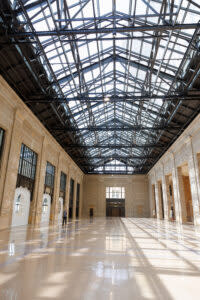
Ford previews the South Concourse of Michigan Central Station on May 14, 2024, following a multi-million dollar renovation to save the decaying train station after it had been abandoned for decades. (Photo by Andrew Roth/Michigan Advance)
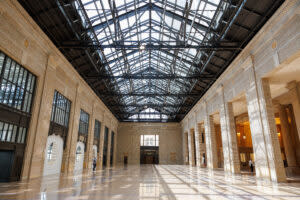
Ford previews the South Concourse of Michigan Central Station on May 14, 2024, following a multi-million dollar renovation to save the decaying train station after it had been abandoned for decades. (Photo by Andrew Roth/Michigan Advance)

Ford previews the South Concourse of Michigan Central Station on May 14, 2024, following a multi-million dollar renovation to save the decaying train station after it had been abandoned for decades. (Photo by Andrew Roth/Michigan Advance)

Ford previews the South Concourse of Michigan Central Station on May 14, 2024, following a multi-million dollar renovation to save the decaying train station after it had been abandoned for decades. (Photo by Andrew Roth/Michigan Advance)
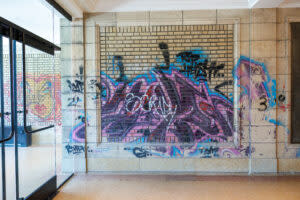
Ford previews the South Concourse of Michigan Central Station on May 14, 2024, following a multi-million dollar renovation to save the decaying train station after it had been abandoned for decades. (Photo by Andrew Roth/Michigan Advance)

Ford previews the South Concourse of Michigan Central Station on May 14, 2024, following a multi-million dollar renovation to save the decaying train station after it had been abandoned for decades. (Photo by Andrew Roth/Michigan Advance)

Ford previews the South Concourse of Michigan Central Station on May 14, 2024, following a multi-million dollar renovation to save the decaying train station after it had been abandoned for decades. (Photo by Andrew Roth/Michigan Advance)

Ford previews the Grand Hall of Michigan Central Station on May 14, 2024, following a multi-million dollar renovation to save the decaying train station after it had been abandoned for decades. (Photo by Andrew Roth/Michigan Advance)
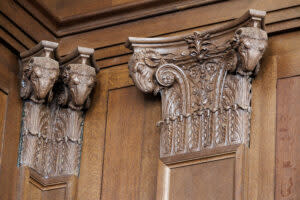
Ford previews the men's and women's waiting rooms of Michigan Central Station on May 14, 2024, following a multi-million dollar renovation to save the decaying train station after it had been abandoned for decades. (Photo by Andrew Roth/Michigan Advance)

Ford previews the ticket office of Michigan Central Station on May 14, 2024, following a multi-million dollar renovation to save the decaying train station after it had been abandoned for decades. (Photo by Andrew Roth/Michigan Advance)

Ford previews the Grand Hall of Michigan Central Station on May 14, 2024, following a multi-million dollar renovation to save the decaying train station after it had been abandoned for decades. (Photo by Andrew Roth/Michigan Advance)
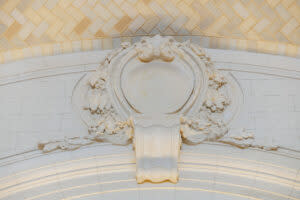
Ford previews the Grand Hall of Michigan Central Station on May 14, 2024, following a multi-million dollar renovation to save the decaying train station after it had been abandoned for decades. (Photo by Andrew Roth/Michigan Advance)

Ford previews the Grand Hall of Michigan Central Station on May 14, 2024, following a multi-million dollar renovation to save the decaying train station after it had been abandoned for decades. (Photo by Andrew Roth/Michigan Advance)

Ford previews the Grand Restaurant of Michigan Central Station on May 14, 2024, following a multi-million dollar renovation to save the decaying train station after it had been abandoned for decades. (Photo by Andrew Roth/Michigan Advance)
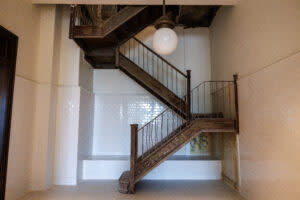
Ford previews the Grand Restaurant of Michigan Central Station on May 14, 2024, following a multi-million dollar renovation to save the decaying train station after it had been abandoned for decades. A nearby service hallway contains dummywaiters for lifting food from the downstairs kitchen, as well as an untouched set of stairs that would have been used by workers to take their lunch into the tower. (Photo by Andrew Roth/Michigan Advance)
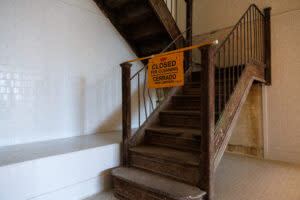
Ford previews the Grand Restaurant of Michigan Central Station on May 14, 2024, following a multi-million dollar renovation to save the decaying train station after it had been abandoned for decades. A nearby service hallway contains dummywaiters for lifting food from the downstairs kitchen, as well as an untouched set of stairs that would have been used by workers to take their lunch into the tower. (Photo by Andrew Roth/Michigan Advance)

Ford previews the Grand Hall of Michigan Central Station on May 14, 2024, following a multi-million dollar renovation to save the decaying train station after it had been abandoned for decades. (Photo by Andrew Roth/Michigan Advance)

Ford previews the Grand Hall of Michigan Central Station on May 14, 2024, following a multi-million dollar renovation to save the decaying train station after it had been abandoned for decades. Signs of the past remain in the Grand Hall's rose marble floors, where areas of the floor have been worn away from people swinging their feet while sitting on benches waiting for their train. (Photo by Andrew Roth/Michigan Advance)

Ford previews the Grand Hall of Michigan Central Station on May 14, 2024, following a multi-million dollar renovation to save the decaying train station after it had been abandoned for decades. Mankato columns have a unique texture as a result of water eroding them over the years. The columns were restored but were not filled in. (Photo by Andrew Roth/Michigan Advance)

Ford previews the ticket office of Michigan Central Station on May 14, 2024, following a multi-million dollar renovation to save the decaying train station after it had been abandoned for decades. (Photo by Andrew Roth/Michigan Advance)
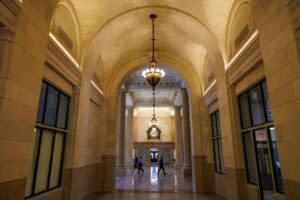
Ford previews the ticket office of Michigan Central Station on May 14, 2024, following a multi-million dollar renovation to save the decaying train station after it had been abandoned for decades. (Photo by Andrew Roth/Michigan Advance)

Ford previews the ticket office of Michigan Central Station on May 14, 2024, following a multi-million dollar renovation to save the decaying train station after it had been abandoned for decades. (Photo by Andrew Roth/Michigan Advance)

Ford previews the ticket office of Michigan Central Station on May 14, 2024, following a multi-million dollar renovation to save the decaying train station after it had been abandoned for decades. (Photo by Andrew Roth/Michigan Advance)
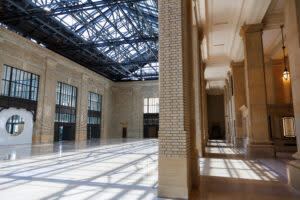
Ford previews the South Concourse of Michigan Central Station on May 14, 2024, following a multi-million dollar renovation to save the decaying train station after it had been abandoned for decades. (Photo by Andrew Roth/Michigan Advance)
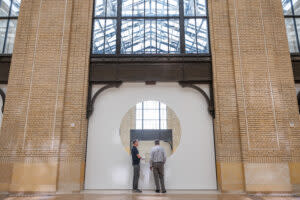
Ford previews the South Concourse of Michigan Central Station on May 14, 2024, following a multi-million dollar renovation to save the decaying train station after it had been abandoned for decades. (Photo by Andrew Roth/Michigan Advance)

Melissa Ditmer, head of place at Michigan Central, previews the South Concourse of Michigan Central Station on May 14, 2024, following a multi-million dollar renovation to save the decaying train station after it had been abandoned for decades. Because the floors in this area had to be completely replaced after being severely damaged by weather, Ford was able to install in-floor cooling. (Photo by Andrew Roth/Michigan Advance)

Michigan Central head of place Melissa Ditmer, left, and Michigan Central chief executive officer Joshua Sirefman, right, preview the South Concourse of Michigan Central Station on May 14, 2024, following a multi-million dollar renovation to save the decaying train station after it had been abandoned for decades. (Photo by Andrew Roth/Michigan Advance)

Michigan Central head of place Melissa Ditmer, left, and Michigan Central chief executive officer Joshua Sirefman, right, preview the Grand Restaurant of Michigan Central Station on May 14, 2024, following a multi-million dollar renovation to save the decaying train station after it had been abandoned for decades. (Photo by Andrew Roth/Michigan Advance)

Michigan Central head of place Melissa Ditmer, left, and Michigan Central chief executive officer Joshua Sirefman, right, preview the Grand Restaurant of Michigan Central Station on May 14, 2024, following a multi-million dollar renovation to save the decaying train station after it had been abandoned for decades. (Photo by Andrew Roth/Michigan Advance)

Ford previews the men's and women's waiting rooms of Michigan Central Station on May 14, 2024, following a multi-million dollar renovation to save the decaying train station after it had been abandoned for decades. (Photo by Andrew Roth/Michigan Advance)

Ford previews the men's and women's waiting rooms of Michigan Central Station on May 14, 2024, following a multi-million dollar renovation to save the decaying train station after it had been abandoned for decades. (Photo by Andrew Roth/Michigan Advance)

Ford previews the Grand Hall of Michigan Central Station on May 14, 2024, following a multi-million dollar renovation to save the decaying train station after it had been abandoned for decades. (Photo by Andrew Roth/Michigan Advance)

Ford previews the Grand Hall of Michigan Central Station on May 14, 2024, following a multi-million dollar renovation to save the decaying train station after it had been abandoned for decades. (Photo by Andrew Roth/Michigan Advance)

Ford previews the Grand Hall of Michigan Central Station on May 14, 2024, following a multi-million dollar renovation to save the decaying train station after it had been abandoned for decades. (Photo by Andrew Roth/Michigan Advance)
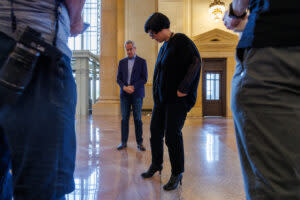
Melissa Ditmer, head of place at Michigan Central, previews the Grand Hall of Michigan Central Station on May 14, 2024, following a multi-million dollar renovation to save the decaying train station after it had been abandoned for decades. Signs of the past remain in the Grand Hall's rose marble floors, where areas of the floor have been worn away from people swinging their feet while sitting on benches waiting for their train. (Photo by Andrew Roth/Michigan Advance)
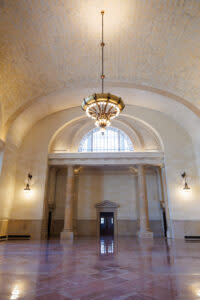
Ford previews the Grand Hall of Michigan Central Station on May 14, 2024, following a multi-million dollar renovation to save the decaying train station after it had been abandoned for decades. (Photo by Andrew Roth/Michigan Advance)

Michigan Central head of place Melissa Ditmer previews the ticket office of Michigan Central Station on May 14, 2024, following a multi-million dollar renovation to save the decaying train station after it had been abandoned for decades. Mankato columns have a unique texture as a result of water eroding them over the years. The columns were restored but were not filled in. (Photo by Andrew Roth/Michigan Advance)

Michigan Central chief executive officer Joshua Sirefman, left, and Michigan Central head of place Melissa Ditmer, right, preview the ticket office of Michigan Central Station on May 14, 2024, following a multi-million dollar renovation to save the decaying train station after it had been abandoned for decades. (Photo by Andrew Roth/Michigan Advance)

Ford previews the East Arcade of Michigan Central Station on May 14, 2024, following a multi-million dollar renovation to save the decaying train station after it had been abandoned for decades. While the walls are made to look like stone, they are actually plaster. The rose marble around the perimeter of the floor is original. (Photo by Andrew Roth/Michigan Advance)

Michigan Central chief executive officer Joshua Sirefman, left, and Michigan Central head of place Melissa Ditmer, right, preview the East Arcade of Michigan Central Station on May 14, 2024, following a multi-million dollar renovation to save the decaying train station after it had been abandoned for decades. While the walls are made to look like stone, they are actually plaster. The rose marble around the perimeter of the floor is original. (Photo by Andrew Roth/Michigan Advance)

Ford previews the East Arcade of Michigan Central Station on May 14, 2024, following a multi-million dollar renovation to save the decaying train station after it had been abandoned for decades. While the walls are made to look like stone, they are actually plaster. The rose marble around the perimeter of the floor is original. (Photo by Andrew Roth/Michigan Advance)
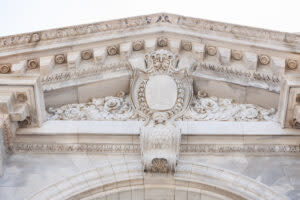
The exterior facade of Michigan Central Station on May 14, 2024. Ford negotiated to reopen the Dark Hollow quarry where limestone used on the historic structure was originally sourced to ensure sections that had to be reconstructed would fit in. There is some color variation from a natural aging and patina process. (Photo by Andrew Roth/Michigan Advance)

Ford previews the Grand Hall of Michigan Central Station on May 14, 2024, following a multi-million dollar renovation to save the decaying train station after it had been abandoned for decades. (Photo by Andrew Roth/Michigan Advance)
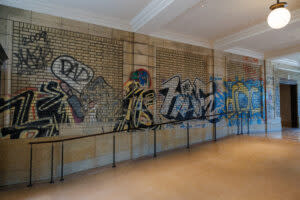
Ford previews the South Concourse of Michigan Central Station on May 14, 2024, following a multi-million dollar renovation to save the decaying train station after it had been abandoned for decades. (Photo by Andrew Roth/Michigan Advance)

Ford previews the Grand Hall of Michigan Central Station on May 14, 2024, following a multi-million dollar renovation to save the decaying train station after it had been abandoned for decades. (Photo by Andrew Roth/Michigan Advance)

Ford previews the Grand Hall of Michigan Central Station on May 14, 2024, following a multi-million dollar renovation to save the decaying train station after it had been abandoned for decades. (Photo by Andrew Roth/Michigan Advance)

Ford previews the men's and women's waiting rooms of Michigan Central Station on May 14, 2024, following a multi-million dollar renovation to save the decaying train station after it had been abandoned for decades. (Photo by Andrew Roth/Michigan Advance)

Ford previews the men's and women's waiting rooms of Michigan Central Station on May 14, 2024, following a multi-million dollar renovation to save the decaying train station after it had been abandoned for decades. (Photo by Andrew Roth/Michigan Advance)

Ford previews the Grand Restaurant of Michigan Central Station on May 14, 2024, following a multi-million dollar renovation to save the decaying train station after it had been abandoned for decades. A nearby service hallway contains dummywaiters for lifting food from the downstairs kitchen, as well as an untouched set of stairs that would have been used by workers to take their lunch into the tower. (Photo by Andrew Roth/Michigan Advance)
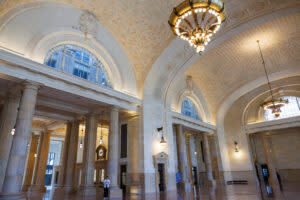
Ford previews the Grand Hall of Michigan Central Station on May 14, 2024, following a multi-million dollar renovation to save the decaying train station after it had been abandoned for decades. Passengers would sit on a heated bench with this view and monitor the clock while waiting for their train. (Photo by Andrew Roth/Michigan Advance)

Ford previews the Grand Hall of Michigan Central Station on May 14, 2024, following a multi-million dollar renovation to save the decaying train station after it had been abandoned for decades. Mankato columns have a unique texture as a result of water eroding them over the years. The columns were restored but were not filled in. (Photo by Andrew Roth/Michigan Advance)
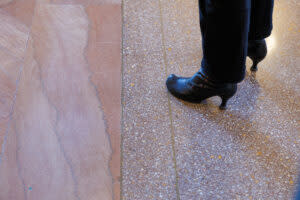
Melissa Ditmer, head of place at Michigan Central, previews the Grand Hall of Michigan Central Station on May 14, 2024, following a multi-million dollar renovation to save the decaying train station after it had been abandoned for decades. Signs of the past remain in the Grand Hall's rose marble floors, where areas of the floor have been worn away from people swinging their feet while sitting on benches waiting for their train. (Photo by Andrew Roth/Michigan Advance)
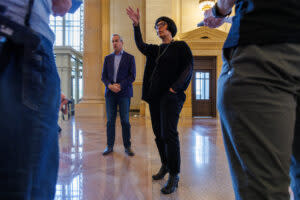
Melissa Ditmer, head of place at Michigan Central, previews the Grand Hall of Michigan Central Station on May 14, 2024, following a multi-million dollar renovation to save the decaying train station after it had been abandoned for decades. Signs of the past remain in the Grand Hall's rose marble floors, where areas of the floor have been worn away from people swinging their feet while sitting on benches waiting for their train. (Photo by Andrew Roth/Michigan Advance)
The post Michigan Central Station reopens in its ‘most pristine state ever’ appeared first on Michigan Advance.

